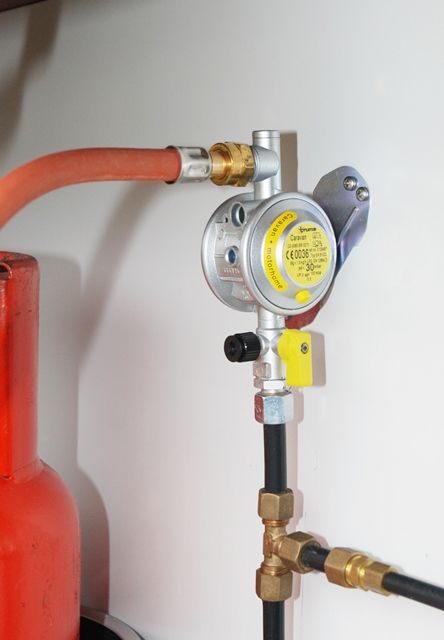
A Truma regulator with pigtail
As can be seen in the chart, many cylinders have a significant weight and this must be considered when loading a caravan or motorhome. Most gas lockers are in the front of a caravan and will affect the noseweight of the unit. So gas cylinders and anything else you add comes out of the user payload.
In general a high noseweight brings improved stability, but there are limits fixed by both towcar and caravan manufacturers that must not be exceeded. For example, carrying two full 6kg Calor cylinders (a common fitting) add almost 28kg to the noseweight. If this proves to be a problem and you need to transport the cylinders elsewhere, they must be properly secured.
The Club does not recommend carrying gas cylinders in the car, but if this must be done they should always be kept upright and secured in place. One alternative may be to use Gaslight composite cylinders supplied by Flogas (formerly BP Gaslight).
When the new regulators were introduced in 2003, the UK opted to use bulkhead-mounted regulators rather than the previous cylinder-mounted versions. These can be used in Europe where a local cylinder can be connected to the exiting regulator using a suitable flexible high-pressure pipe, or - pigtail - with an appropriate adaptor.
Which gas?
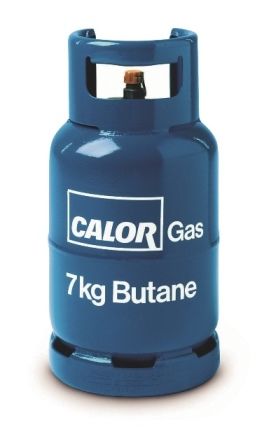
Which gas best suits you will depend on how many appliances you have, their gas requirements and the temperature. Propane gas is better at supplying a larger number of appliances at the same time due to its greater off-take rate (see right), and it can be used in sub-zero temperatures, whereas butane begins to produce less gas below about 4C.
Now that the price of the two gases is very similar there's little advantage to buying butane, though you do get marginally more energy from a butane cylinder than a propane one of the same volume and if you are a warm-weather caravanner butane will be fine.
Locating LPG cylinders
In recent years it has been difficult to locate suitable cylinders, normally camping and caravan accessory shops, motorhome dealers and sometimes fuel stations may have suitable stock. Most of the brands have major depots that may hold a stock of cylinders so check their website listing in the contacts area of this Data Sheet for the latest information as they may even deliver to your door. The Camping-Gas website has an up to date directory of retailers for cylinders, we recommend using the location, supplier or size to filter the database. Remember to call first to ensure the retailer still provides the required service and avoid a wasted journey.
Gas Overseas
Calor Gas remains the first choice of many campers in the UK, however is not available on mainland Europe, so there are four possible options:
1. Carry sufficient gas to last your whole stay, for a two to three week stay in the summer on a site with electric hook-up two 6kg propane cylinders will be sufficient for most. Crossing providers do have limits on LPG, check their website for current limits.
2. Supplement your supply with Campingaz, which is widely available on the European mainland. Visit their website and use the store locator tool.
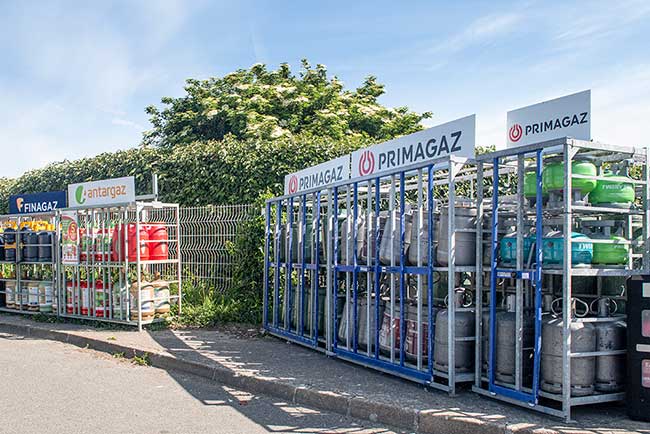
Wide choice at French forecourts
3. Go native, purchase a bottle and regulator or adaptor as necessary in the country you’re staying in. In Spain you must provide a local certificate of gas safety when buying a cylinder for the first time, there after it is simply an exchange process as in the UK. Local campsite staff should be able to tell you where to find a local workshop for this. There's a huge choice of bottles in France.
4. Have a refillable system installed or have a self-refillable cylinder. Most countries in mainland Europe have an extensive network of LPG or Autogas filling points at fuel forecourts. It is worth noting there’s four common types of connector and not many countries use the bayonet type we have in the UK, check with your supplier what adaptor(s) you may need. The gas supplied is predominantly propane.
A good resource for finding outlets while abroad is MyLPG.EU ,do remember to call first to ensure the retailer still provides the required service.
Ferry crossings and tunnels
UK tunnels can be used by vehicles carrying removable cylinders provided the gas is turned off at the cylinder valve, though there may be a limit on the total amount of gas carried, normally well in excess of the amount on a caravan or motorhome. It is worth noting vehicles propelled by LPG or other compressed gas are not permitted on Eurotunnel trains.
Roll-on roll-off ferries have similar rules, though there are some variations both in the UK and continental Europe so check with your ferry operator. Generally, the number of cylinders you are carrying must be declared to the ferry company and to ship's officers, and there must be no more than three (two in the case of some operators). All must be secured against movement and shut off at the cylinder valve during the voyage. Eurotunnel currently permits a maximum of 50kg of gas to be carried with the portable cylinders and 47Kg for a fixed installation both turned off and isolated.
If you have a motorhome with a fixed LPG tank be aware that some tunnels and ferries may limit the amount of gas that can be carried, so check with the operator first.
How much gas do you need?
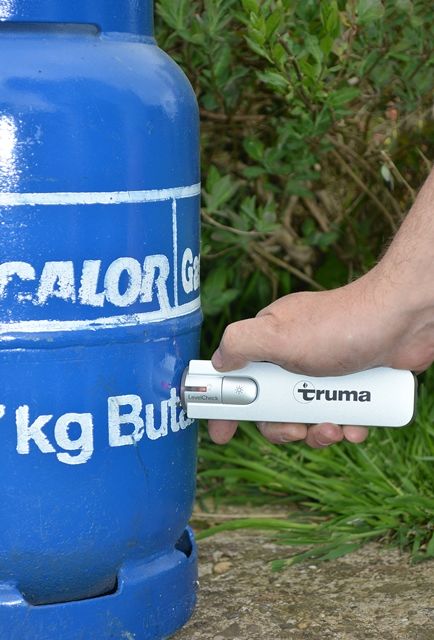
Red indicator on Truma LevelCheck denotes no LPG at that level
The amount of gas you need depends on the ambient temperature, the number of gas appliances in use, the power they are using and how long they are in use at that rate. However, few of us ever bother to work all this out, as we simply use the gas until it runs out and then change the cylinder. As a rough guide, many users find they consume between 0.8 and 1.5kg of gas per day, or say an average of 1.2kg per day. Obviously when the weather is warmer you will use less gas for heating and if you are using an electric hook-up and can use electricity for some heating, cooking and refrigeration, you can make the gas supply last longer.
Cylinders have a habit of running out at inconvenient times, such as in the middle of the night or when it is raining, so it is often wise to know when your gas is running low. Some cylinders have a contents gauge or are translucent, so the contents can be seen. The majority of steel cylinders have no means of revealing the contents, but there are after-market devices such as Truma's Gas LevelCheck that can provide an indication.
You can also weigh the cylinders on bathroom scales and use the total weight figures in the table to see how full they are. Alternatively you can buy changeover valves as made by Gaslow or Truma that will automatically change cylinders if you are carrying two - but remember they still need monitoring or you will just end up with two empty cylinders.
Perhaps more important though is to be sure the gas you have will supply all the appliances you want to have on at the same time.
A single 6kg propane cylinder will have an available maximum off-take (supply) rate of up to about 0.8kg per hour. This will be sufficient for a cooker, space heater, fridge and water heater, but if you use all these and the grill and four gas rings at the same time you might find the cylinder cannot cope with the demand.
When this happens the appliances may not work efficiently and some may go out. A flame failure device should always be fitted, to prevent any unburnt gas getting into the living area. In practise, this problem rarely happens unless you have chosen a smaller size of cylinder (such as a 3.9kg propane cylinder with a maximum off-take of just 0.5kg/hr) or are using butane gas in near-freezing conditions.
Refillable cylinders
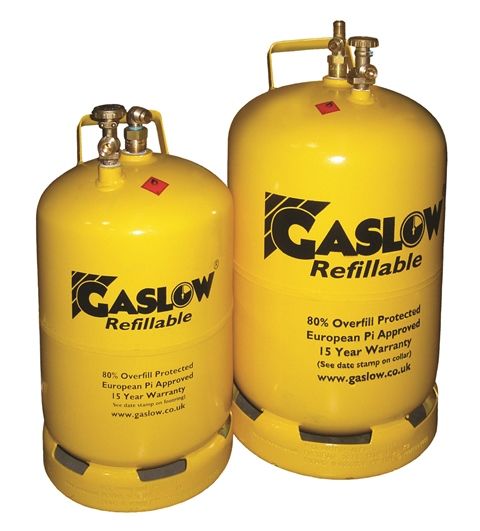
Refilling an existing cylinder rather than replacing it seems a good idea, but there are many practical, safety and legal issues involved. Only authorised LPG depots are allowed to do this and you cannot do it yourself with a conventional cylinder. There are some cylinders that are designed to be refilled by the user. Gaslow, Safefill and Gas It system allows refilling from the Autogas pump at fuel stations.
In this system you purchase a special cylinder, which has a steel hose connected to an automotive type filler. This is fitted into the bodywork of your unit and accepts the LPG delivery nozzle at fuel stations. As with LPG-powered cars, adapters are needed for filling in continental Europe. Availability of Autogas varies considerably within the continent. Safefill provide a freestanding system which can be filled at many Autogas retailers.
All systems should have an inbuilt cut-off system ensures filling the cylinder cannot exceed the important limit of no more than 80 per cent full (to allow sufficient space for the LPG to expand) and an overpressure release valve and a form of contents gauge are also provided. It is important to remember you are dealing with a fuel delivery system under considerable pressure so care is needed for safe operation. Follow the instructions carefully. Users report that some fuel stations refuse to allow caravanners to refill in this way.
For those requiring refill of Autogas in fixed tanks or specifically designed portable cylinders there is a page on the Camping-Gas website that allows filtering for the location and brand of cylinder.
Caution: Some caravanners have been offered a refilling service for conventional UK-based cylinders when travelling in Europe. The Club does not recommend this practice as over filling could occur, which presents a significant risk to your safety.
Fixed on-board tanks
It is more common for larger motorhomes to have fixed tanks that can also be filled at LPG fuel stations. They usually contain considerably more gas than can be carried in removable cylinders and are ideal for continental touring . There is, however, a weight and cost penalty and the extra weight will reduce your available vehicle payload. Do beware of under slung tanks and always ensure they have been fitted to a good standard and provide adequate road clearance. The NCC has a code of practise for fixed installations which any good installer should be adhering to.